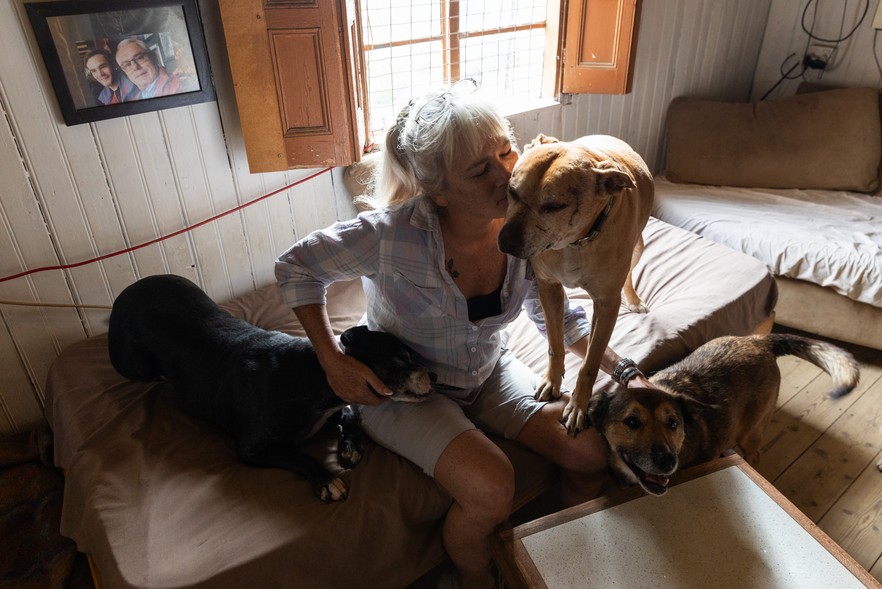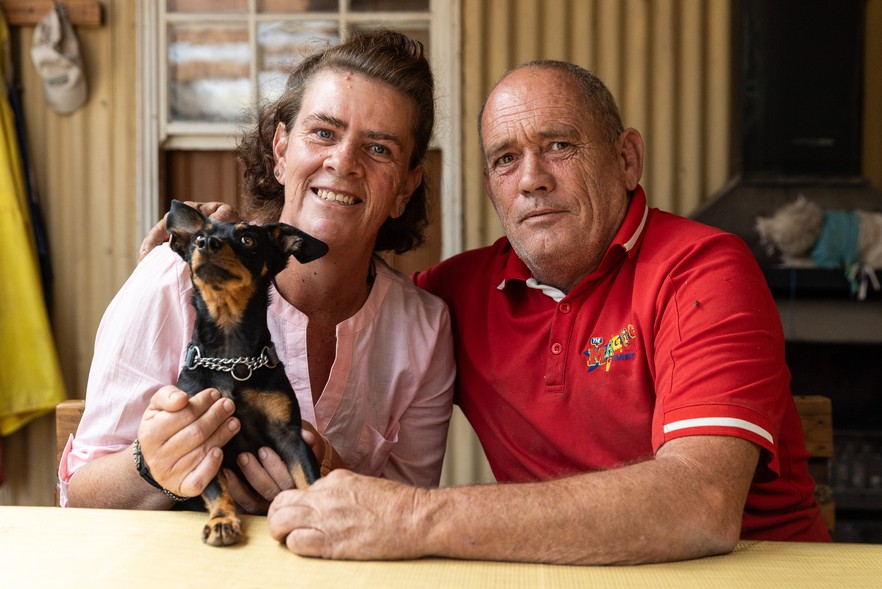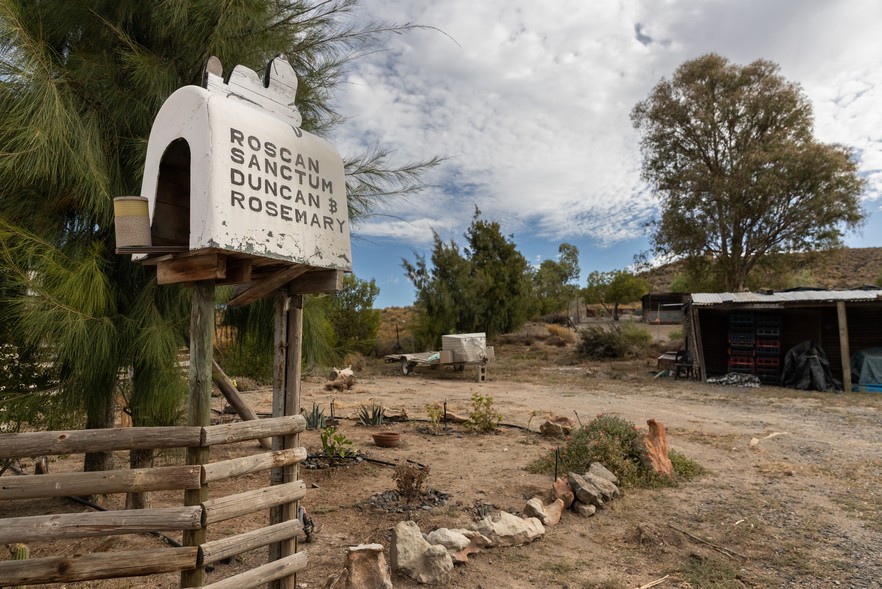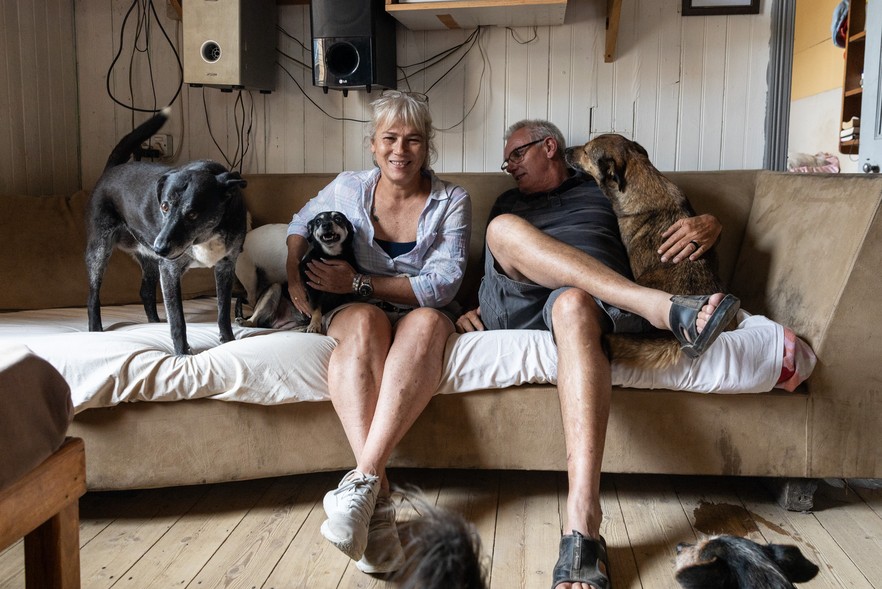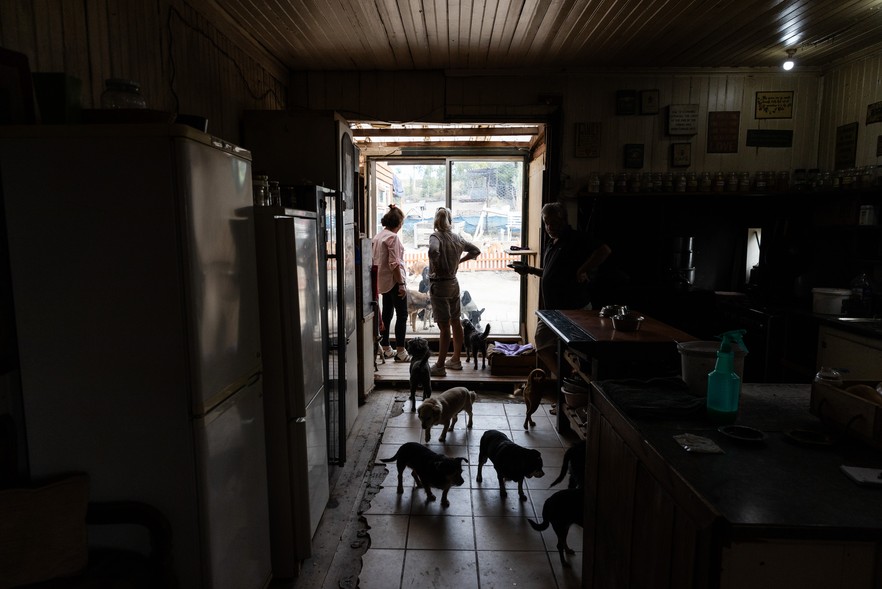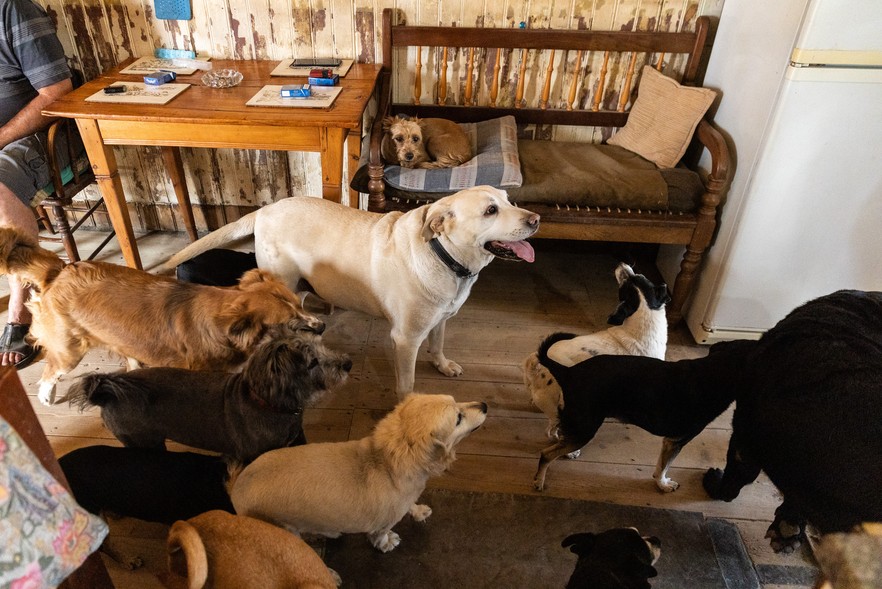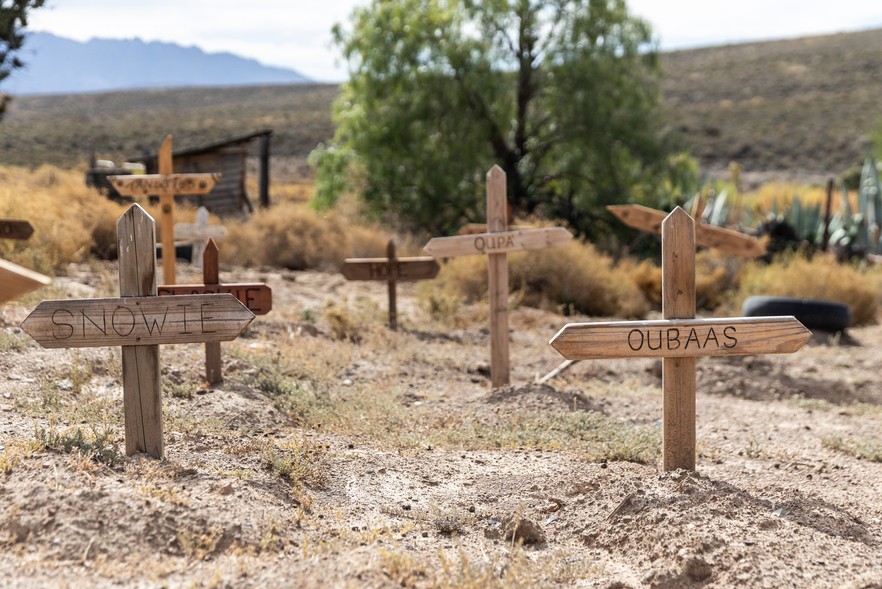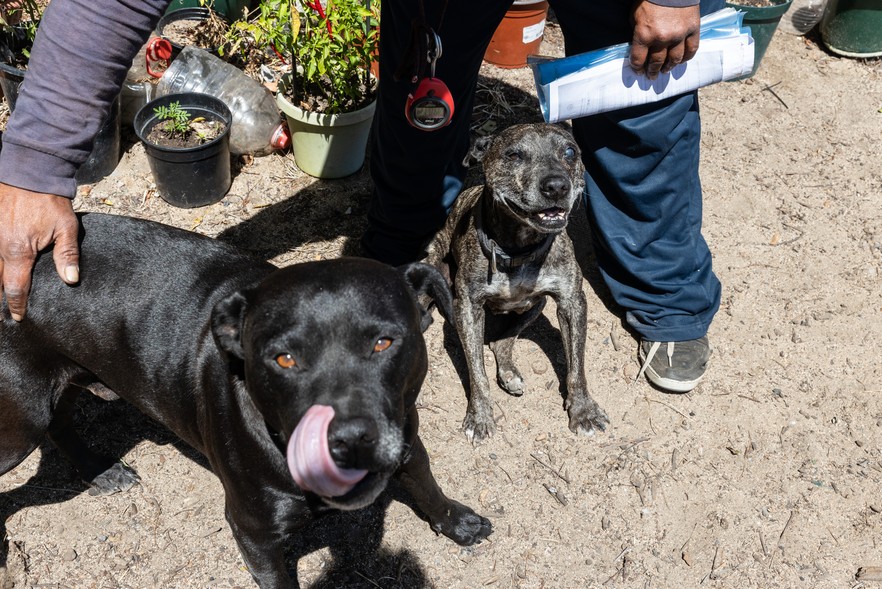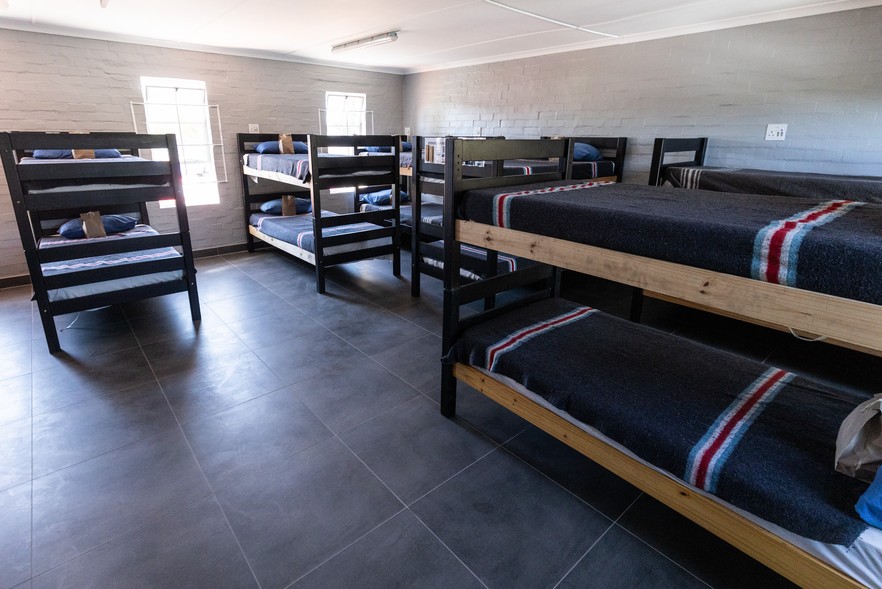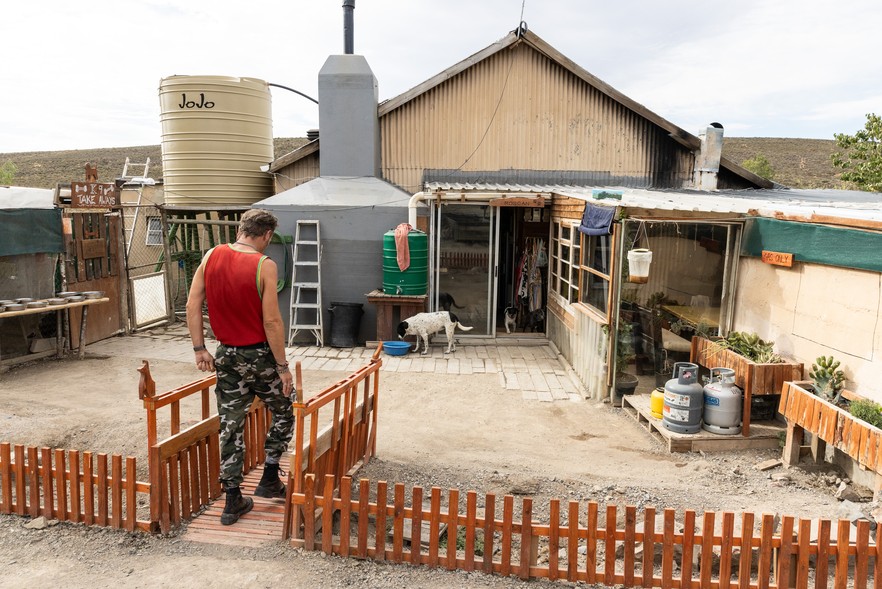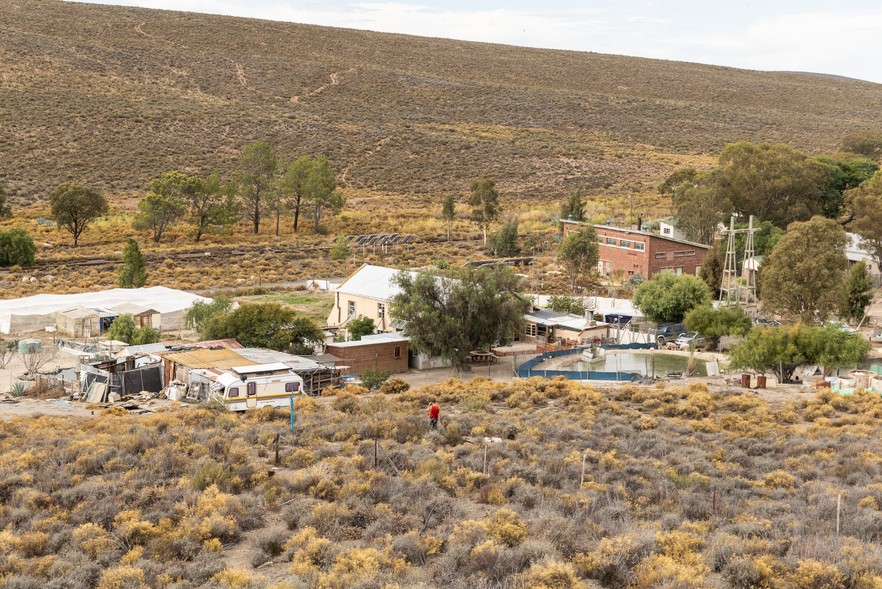No shelter for homeless dog owners
Except perhaps for a farm in the Karoo
Rosemary Briggs, who is one of the founders of Roscan Sanctum, kisses one of the over 40 dogs that currently live on their farm.
A dog may be a person’s “best friend” but for homeless people, there are almost no shelters that will take them and their four-legged companions.
Nico and Amanda Von Wielligh found themselves without work and homeless in George. Having nowhere to go, they slept outside a church with their two dogs, Seuntjies and Tinkles. Nico said living on the cold streets wasn’t fair on the dogs. They are “basically our children”, he said.
Not knowing what else to do they decided to surrender the dogs to the SPCA and moved into a homeless night shelter. “It was very hard” and we didn’t want our dogs to “suffer” , said Amanda. After a week, the SPCA introduced them to Roscan Sanctum, a sanctuary for dogs and humans. And this is where Nico, Amanda and their two dogs have lived for over a year.
Nico and Amanda Von Wielligh and their two dogs Seuntjies (pictured) and Tinkles have been staying at Roscan Sanctum for over a year.
Roscan Sanctum is unusual. In the Karoo town of Touws River, it’s not quite a shelter but rather a home with rescued dogs and farm animals including sheep, pigs and geese. The 48 hectare farm is separated into a number of wendy houses with beds, enclosures for the animals, a woodwork workshop and greenhouse. They call themselves a “self-sustaining, all-volunteer village”.
Everyone who lives on the farm gets three meals a day and has access to the internet. It’s free to stay and everything is paid for. The residents do farm work, gardening, woodworking, cooking and all the house chores that come with looking after a home with over 40 of dogs roaming freely. Living here also means you shower once a day and sit together at a table for meals.
Roscan Sanctum is in Touws River and is a “self-sustaining, all-volunteer village”’ with animals and people.
“We try and treat everyone as part of our family,” said Duncan Briggs, who started the sanctuary with his wife Rosemary in 2015. Back then it was only dogs but in 2017 they started working with people too. This included families with children, elderly people and people with pets.
Seventeen humans, including the founders, as well as 49 dogs currently live on the farm. “There is a lot of synergy between broken people and dogs,” said Duncan. He said that they can be therapeutic and “very good for lost people”.
Duncan and Rosemary Briggs started Roscan Sanctum in 1999. It was originally only made to re-home dogs but they started working with people from 2017.
The sanctuary acts as a type of halfway home to get people back on their feet, into jobs or reconnected with families. They also assist with admin such as obtaining IDs, driver’s licences and CVs. They have helped place older people into old age homes.
Most of the people who have come to live here, have been referred by the SPCA or shelters. “Our attitude is they got a reference to us, we’ll give them a chance, but it’s on our rules,” said Duncan.
Most of the dogs roam freely and even sleep in beds with some of the people living on the farm.
He said that they don’t take in people that have been living on the street for a long period and have become “accustomed” to living that way. “A lot of people don’t like the structure and the discipline”. The sanctuary has a zero drug and alcohol use policy. In the last five years, over 200 people have made their way through here.
The dogs on the farm are not up for adoption. “We’re a retirement home for dogs, ” said Duncan Briggs.
The graveyard on the farm has 44 dogs and two cats buried in it. “We’re not a rescue. we don’t kennel and cage” said Duncan Briggs. He said that they want the home to be as close to a “normal home” for dogs as possible.
James Killa has been staying for over 20 years in a tent on a piece of public land in Constantia. He keeps the place neat and clean and gets by with donations and doing a bit of gardening work. He has two dogs named Madam and Joshua.
“I’m not going to leave my dogs,” he said when asked why he doesn’t go to a shelter. “They are my friends.” “We play. We eat together. We sleep together. We pray together,” he said laughing.
Killa says that the shelters are too expensive and he isn’t interested in going to a place he knows nothing about. At 51 years old, Killa has been homeless for more than half his life and has stayed in numerous places across the peninsula.
James Killa is homeless and lives on a field in Constantia with his two dogs Madam and Joshua.
Patricia van der Ross, the City of Cape Town’s Mayco Member for Community Services and Health, said that their shelters are not equipped for pets. “Our shared spaces aim to accommodate all clients, taking into consideration potential fears or allergies that some may have towards certain animals.”
Van der Ross said that pets bring about a number of liabilities and safety considerations in communal spaces such as anxiety, conflict and property damage. “The City does not have the necessary resources and infrastructure to adequately support people living on the streets with pets,” she explained.
A bedroom at the new Safe Space Homeless Shelter in Durbanville.
Constantia resident Cherina Strydom and a few other residents have been assisting Killa. “We feed the dogs. We feed him. We give him monthly groceries,” she said and he helps with gardening work and keeps the area clean. “
Strydom reached out to Groundup after Killa received a compliance notice from the Law Enforcements Displaced Peoples Unit. Worried that he might be forced to move, she said that they need to find a solution where he isn’t separated from his dogs. Strydom said that the fact that he has managed to look after his dogs shows that he is “able to care and take care”. She says that taking the dog away from him would just make things worse. They’re a family, she explained.
Strydom said that she understands the limitations at the shelters but the City has to do more. “We need a different solution” she said and made the suggestion of connecting homeless and animal shelters. Strydom said that perhaps homeless people could volunteer at the animal shelter. “Everybody that’s homeless, that has an animal , shows they can care,” she says.
Roscan Sanctum currently has 17 people (including the founders) and 49 dogs.
The running costs of Roscan Sanctum are about R70,000 a month. They provide everything for those living there including lodging, food and toiletries.
Duncan said that their biggest expenses are food and budget about R40 a day per person. They use about 30 bags of dog food a month costing over R2,500. Then there are the other animal feeds which cost over R10,000 a month.
Rosemary said that the vet bills for 49 dogs is expensive. “A good five grand a month on just the basics” , like vaccination and flea treatments, she said.
Roscan Sanctum generates income through woodwork, building projects, food products, donations and income from the nearby Impangele Mountain Lodge in De Doorns. Rosemary said that they are always in need of food and clothing.
Roscan Sanctum is situated on a 48 hectare farm.
Next: Finally, five months after police were filmed assaulting a barber, they have been charged
Previous: Student murdered while trying to be early for NSFAS queue
© 2024 GroundUp. This article is licensed under a Creative Commons Attribution-NoDerivatives 4.0 International License.
You may republish this article, so long as you credit the authors and GroundUp, and do not change the text. Please include a link back to the original article.
We put an invisible pixel in the article so that we can count traffic to republishers. All analytics tools are solely on our servers. We do not give our logs to any third party. Logs are deleted after two weeks. We do not use any IP address identifying information except to count regional traffic. We are solely interested in counting hits, not tracking users. If you republish, please do not delete the invisible pixel.

